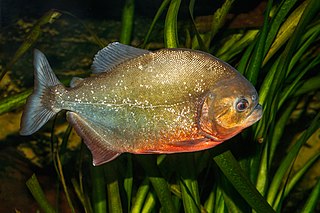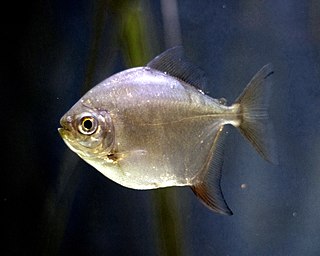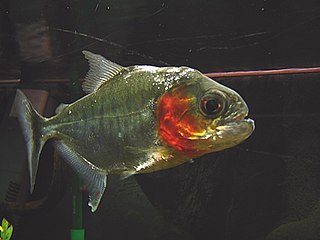
A piranha or piraña is any of a number of freshwater fish species in the family Serrasalmidae, or the subfamily Serrasalminae within the tetra family, Characidae in order Characiformes. These fish inhabit South American rivers, floodplains, lakes and reservoirs. Although often described as extremely predatory and mainly feeding on fish, their dietary habits vary extensively, and they will also take plant material, leading to their classification as omnivorous.

Silver dollar is a common name given to a number of species of fishes, mostly in the genus Metynnis, tropical fish belonging to the family Serrasalmidae which are closely related to piranha and pacu. Most commonly, the name refers to Metynnis argenteus. Native to South America, these somewhat round-shaped silver fish are popular with fish-keeping hobbyists.

Hyphessobrycon is a genus of freshwater fish in the family Characidae. These species are among the fishes known as tetras. The genus is distributed in the Neotropical realm from southern Mexico to Río de la Plata in Argentina. Many of these species are native to South America; about six species are from Central America and a single species, H. compressus is from southern Mexico.

Astyanax is a genus of freshwater fish in the family Characidae of the order Characiformes. Some of these fish, like many of their relatives, are kept as aquarium pets and known collectively as tetras. With around 150 described species and new ones being described yearly, this genus is among the largest of the entire order; Hyphessobrycon also has more than 145 species and which one is larger at any one time depends on whether more species have been recently described in one or the other. The blind and colorless cave tetra of Mexico is a famous member of the genus, but its taxonomic position is disputed: Some recognize it as part of the Mexican tetra and this is supported by phylogenetic evidence, but others recognize the cave form as a separate species, A. jordani.

Leporinus is a genus of fish in the family Anostomidae native to South America. The fossil species Leporinus scalabrinii, known from the late Miocene of Entre Ríos in Argentina, has only recently been added to this genus after being misidentified as a species of primate under the name Arrhinolemur scalabrinii for over 100 years.

The Serrasalmidae (serrasalmids) are a family of characiform fishes, recently elevated to family status. It includes more than 90 species. The name means "serrated salmon family", which refers to the serrated keel running along the belly of these fish. Fish classified as Serrasalmidae are also known by these common names: pacu, piranha, and silver dollar. These common names generally designate differing dental characteristics and feeding habits.
Ossubtus is a genus of fish in the family Serrasalmidae. It contains a single species, Ossubtus xinguense, the parrot pacu or eaglebeak pacu, The species is endemic to rapids in the Xingu River basin in the Brazilian Amazon. This vulnerable species is primarily a herbivore.

Bryconops is a genus of freshwater fish in the family Iguanodectidae from South America. It consists of small fish, all under half-a-foot long, with slender bodies and silvery scales, though there is some mild color variation. Several species can be identified by way of a humeral patch, and others have a reddish ocellus, or eyespot, on one or both lobes of the dorsal fin.

Piaractus brachypomus, the pirapitinga, is a large species of pacu, a close relative of piranhas and silver dollars, in the serrasalmid family. It is native to the Amazon basin in tropical South America, but it formerly included populations in the Orinoco, which was described in 2019 as a separate species, P. orinoquensis. Additionally, P. brachypomus is widely farmed and has been introduced to other regions. In South Florida they are invasive in rivers, canals or lakes.
The Kurupung River is a tributary of the middle Mazaruni River in Guyana.

Myloplus schomburgkii, also known as the Disk tetra, Disk pacu, Black-ear pacu, Black-band myleus or Black-barred myleus is a species of serrasalmid with a black bar on its side. This species is found in the middle and lower Amazon River basin, Nanay River, upper Orinoco River basin in Brazil, Peru, Venezuela and possibly in Suriname.

Myleus is a genus of serrasalmids from South America, where found in the Amazon, Orinoco and São Francisco basins, as well as river basin of the Guiana Shield. They are found in rivers with moderately or fast-flowing water, including rapids. They are primarily herbivores, but also take some animal matter. Depending on the exact species, they reach up to 12–42 cm (0.4–1.4 ft) in standard length, and the adult males have a double-lobed anal fin and filamentous extensions on the dorsal fin. Their strong teeth means that larger individuals can inflict severe bites on humans.

Piaractus is a genus of large serrasalmid from South America. The two traditionally recognized species of Piaractus are very similar in appearance and were formerly included in the genus Colossoma, which currently only contains another similar species, the tambaqui. A third Piaractus was described in 2019 as a new species, but it was formerly considered a subpopulation of P. brachypomus.
Tometes is a genus of fish in the family Serrasalmidae found in fast-flowing rivers in northern South America. Adults of all seven species in this genus are phytophagous, feeding primarily on aquatic plants in the family Podostemaceae.
Utiaritichthys is a genus of serrasalmid fish found in the Amazon and Orinoco basins in tropical South America. The adults are typically found in rapidly flowing water where they feed on aquatic plants in the family Podostemaceae and filamentous algae. They reach up to 32.2 cm (1.06 ft) in standard length.

A clearwater river is classified based on its chemistry, sediments and water colour. Clearwater rivers have a low conductivity, relatively low levels of dissolved solids, typically have a neutral to slightly acidic pH and are very clear with a greenish colour. Clearwater rivers often have fast-flowing sections.
Myloplus nigrolineatus is a species of freshwater fish in the serrasalmid family of order Characiformes. It is native to the Amazon River basin in South America.
Myloplus lucienae is a medium to large omnivorous fish of the family Serrasalmidae from Brazil. It and can grow to a length of 33.8 cm (13.3 in).
Myloplus zorroi is a medium to large omnivorous fish of the family Serrasalmidae from Brazil.
Myloplus tumukumak is a medium to large omnivorous fish of the family Serrasalmidae from the Tumucumaque Mountain Range, in Brazil and French Guiana.












